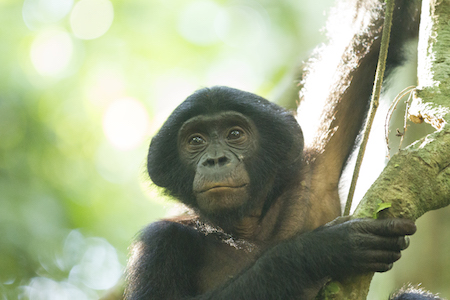
Ulrich, an immature male bonobo studied by LuiKotale Bonobo Project researchers
Pictured here is a young male bonobo whom researchers named Ulrich. He is part of a population of wild bonobos in the Democratic Republic of Congo studied through the LuiKotale Bonobo Project. I took this photo in 2014 when Ulrich was about seven years old. Since then, researchers including myself have learned a great deal about his life. We know who his mother and father are, what he spends most of his time doing, who he hangs out with the most, and how these things have changed over the last four years as he has transitioned from juvenility to adolescence. Because bonobos, along with chimpanzees, are our closest living relatives, the way Ulrich grows and develops can tell us something about how our extinct hominin ancestors may have grown and developed, shedding light on our evolutionary history. But the extremely long developmental periods characteristic of apes has made it difficult to thoroughly study this aspect of their biology, particularly in wild subjects.
In January of this year, Ulrich’s life was drastically altered when he unwittingly walked into a hunting snare. These snares are designed to instantaneously constrict when triggered, becoming almost inseparable from whatever it has trapped. Given the indiscriminate nature of snares, bonobos occasionally fall victim even if they aren’t the intended target of hunters. This is similar to the impact of trawling and ghost nets. In Ulrich’s case, the snare constricted around his hand and fingers, cutting through his skin. He has since completely lost the use of this left hand and has trouble keeping up with the other members of his community. He has been forced to climb trees with only three limbs and has trouble with basic tasks such as foraging. If he survives, the snare will likely continue to alter the course of his life, even if it detaches from what remains of his hand.

The ethics and sustainability of hunting are a complicated and equivocal topic, not only in the Congo basin but throughout the world. However, the fact remains that in the Democratic Republic of Congo, as in many other nations, hunting in government-protected areas such as national parks and reserves is illegal and qualifies as poaching except under specific scientific or administrative circumstances. This is explicitly stated in the constitution of the Democratic Republic of Congo and well-summarized in the US Library of Congress’ executive legal report on wildlife trafficking and poaching in select African jurisdictions (PDF). But while punishable by law in writing, the policing and monitoring of vast tracts of lowland rainforest in practice is difficult, to say the least, and rampant poaching often ensues.
Most readers likely live very far from where these problems occur. But as we sadly become desensitized to the statistics—numbers of elephants slaughtered, hectares of forest clear-cut, percent reduction in ape density—I think it is important to consider the individual animals who may be so deeply affectedby human impacts, such as Ulrich, not only in this context butwhenever animal welfare and conservation is an issue.
Researchers have developed a snare-removal program at LuiKotale. The goal is to raise funds to finance snare-removal patrols throughout the study site. These patrols are led by government conservation rangers, as well as by local affiliates of LuiKotale who are experts in finding and removing snares. If you would like to support these efforts, please visit Bonobo Alive, where you can learn more about this issue and also purchase the coolest bonobo t-shirts ever. T-shirt proceeds directly support these patrols.

Photo Credits: Sean M. Lee; Megan Claase; LuiKotale Bonobo Project; The Bonobo & Congo Biodiversity Initiative


